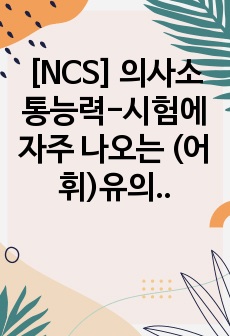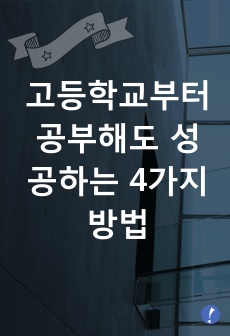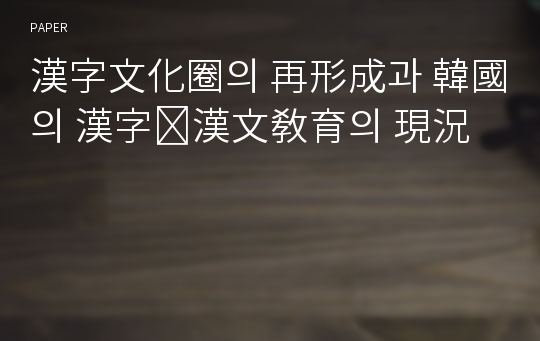漢字文化圈의 再形成과 韓國의 漢字․漢文敎育의 現況
* 본 문서는 배포용으로 복사 및 편집이 불가합니다.
서지정보
ㆍ발행기관 : 한국한자한문교육학회
ㆍ수록지정보 : 漢字漢文敎育 / 26권
ㆍ저자명 : 宋秉烈
ㆍ저자명 : 宋秉烈
목차
Ⅰ. 序論Ⅱ. 近代 以前의 漢字文化圈 言語 交流의 樣相
Ⅲ. 近代 漢字文化圈의 再形成
Ⅳ. 韓國의 漢字․漢文 敎育의 現況
Ⅴ. 結論
한국어 초록
근대 이전 동아시아 여러 나라의 글쓰기는 한문이었다. 당시 동아시아의 세계는 한자·한문 문명권에 속해 있었기 때문에 정치·외교·문화적인 소통을 위하여 당연 히 한문의 글쓰기가 필요했다. 그런데 19세기 후반 이후 이런 전통의 글쓰기와 인 식체계에 큰 변화가 있었다. 표기체계의 획기적인 전환과 함께 문체의 구조적 문 제가 발생하였다. 한문을 보편적으로 구사해오던 동아시아 어문의 질서로부터 이 탈, 근대적인 국민어가 탄생하였다. 근대적인 전환·변혁이 하나의 구체적인 사회 적 현상이 되었기에 그에 대한 언어적인 표현으로 드러난 것이다. 동아시아의 근 대적인 전환과 변혁은 과거의 문물제도와는 다른 학술문화와 지식 체계의 전환을 의미했다. 그런데, 이 시기에 동아시아는 근대 문명의 새로운 언어로 ‘한자 어휘’를 대량산출한다. 그것은 당시 서구의 지식과 학문의 체계를 동아시아권의 언어로 번역하는 과정에서 일어난 일이다. 흥미로운 것은 그렇게도 부정하려고 하고 타자화하려 했던 한자·한문의 문화에서 비롯된 한자 어휘로 서구어를 번역했다는 사실이다. 즉 통사구조는 자국의 구어와 일치시키고, 문장의 내용을 구성하는 어휘는 ‘근대 한자 어휘’로 대체했다. 이는 서양을 수용하면서 언어에 있어서 자국어 운동을 전 개하며 문자표기와 문장을 언어와 일치시키려는 운동이다. 그러나 20세기의 중국을 제외한 동아시아 각국은 한자 어휘마저도 거부하는 어 문 정책을 폈다. 이런 상황 속에서 한국은 2007년 개정 교육과정과 2009년 개정 교육과정에서 초등학교는 여전히 한자 교육을 배제하고, 중·고등학교의 한문 교육 도 이전에 비해 훨씬 축소되었다. 따라서 근대 형성된 동아시아의 한자 어휘 문화 권도 위기를 맞고 있다. 이에 아시아 여러 나라들의 학술활동의 국제적인 연대가 필요하다.영어 초록
In East-Asia, before modern times, writings in several country were written in Han Character. At that time, because the world of East-Asia belonged to Han Character and Classics cultural sphere, for the political, diplomatic and cultural communication naturally they needed Han Character writing. However, after the late 19th century, a great change happened that these traditional writing and recognition system faltered from the foundation. With the innovative changeover of writing system, structural problem of writing style occurred. It shed the order of East-Asian language and writing which used Han Character in common, modern national language was born. Movement of modern national language was not launched unexpectedly on the linguistic side. Modern change and innovation has been a concrete social phenomenon so that it emerged linguistic expression. Modern change and innovation of East-Asian entering upon 20 century were the replacement of academic culture and knowledge system different from the past civilization and regime. For that, East-Asia which had interchanged in a culture sphere before was disorganized by force. It is what changed the linguistic order, which is usage of Han Character that keep East-Asia for a long time modernistic. Each countries came to persue the sentence system and orthography coinciding with their spoken English from linguistic system which had written sentences in Han Character. Thereupon, the circumstance of East-Asian empire has changed largely and got to where we are today. They were boycott of Han Character and Classics culture. Boycott of Han Character and Classics culture was the course that each countries had to experience in the modern age of innovation and connected to dissolution of Han Character culture sphere. But, in other side, it was the consequence that obsession of East-Asia overwhelmed by Occidental civilization had operated in those days. However, in this period East-Asia produce 'Han Character vocabulary' for new language of modern civilization in large scale. It happened on the course of translating Western knowledge and learning system into East-Asian language at that time. East-Asian countries tried to translate knowledge and information about Occidental civilization into national language they newly supported. What is the interest thing on this process is that they translated Western language into Han Character vocabulary originated from Han Character and Classics they tried to boycott. That is, it is that syntactic rules confirmed to national spoken language and the vocabulary which compose contents of sentences replaced it with 'Modern Chinse Character Vocabulary'. This means that accepting the West and developing the national language movement about language they doesn't replace new Western knowledge with Western language or native tongue but did it with Chinse Character and Classics' coinage. However each country of East-Asia except China in 20th century carried out policies that broke with even Han Character Vocabulary. In this situation, Han Character education of Korean in elementary school was excluded in 2007 and 2009 revised education curriculum, also, Han Character education of middle and high school was minimuzed much better than before. So, Han Character vocabulary culture sphere of East-Asia is in pinch. Therefore, it needs the research activities of many Asian countries and international bonds.참고 자료
없음태그
#漢字文化圈言語交流#筆談#唱和#漢字文化圈#近代漢字語의 普 遍性#漢字語文化圈#漢字語의 同異性#Languge exchange of Han Character culture sphere#Communication in writing#exchanging poems#Han Character culture sphere#Generality of modern Han Character vocabulary#Han Character-word culture sphere#Same and different meaning of Han Character vocabulary
"漢字漢文敎育"의 다른 논문
 愉快有效的漢字部件識字法18페이지
愉快有效的漢字部件識字法18페이지 字本位 “读识读”14페이지
字本位 “读识读”14페이지 漢字文化圈의 變化와 漢字․漢文敎育의 새로운 방향 모색45페이지
漢字文化圈의 變化와 漢字․漢文敎育의 새로운 방향 모색45페이지 應用科技幫助建立漢字的觀念15페이지
應用科技幫助建立漢字的觀念15페이지 外国語教育としての漢字字形の相違に対する認識の必要性17페이지
外国語教育としての漢字字形の相違に対する認識の必要性17페이지 東亞細亞 三國의 大學入試 漢文 試驗 比較 考察62페이지
東亞細亞 三國의 大學入試 漢文 試驗 比較 考察62페이지 韓國의 漢文科 敎育課程42페이지
韓國의 漢文科 敎育課程42페이지 漢文科 統合 授業을 위한 敎授․學習 활동29페이지
漢文科 統合 授業을 위한 敎授․學習 활동29페이지 非华人学生学习华人母语教材的汉字教学策略15페이지
非华人学生学习华人母语教材的汉字教学策略15페이지 香港南亞裔學生學習寫字的困難15페이지
香港南亞裔學生學習寫字的困難15페이지


























